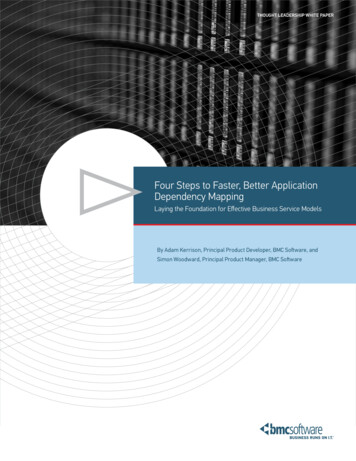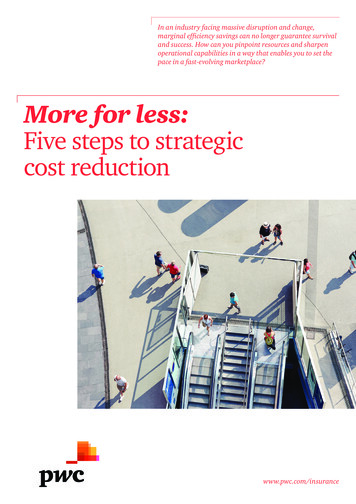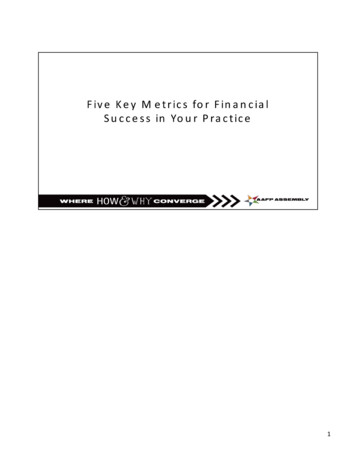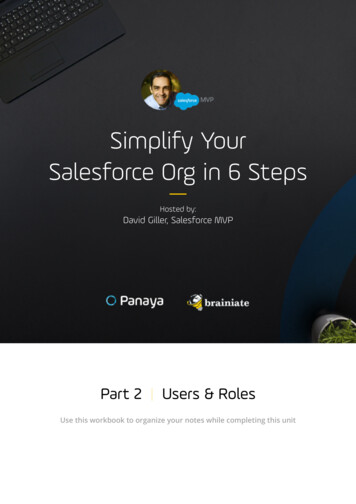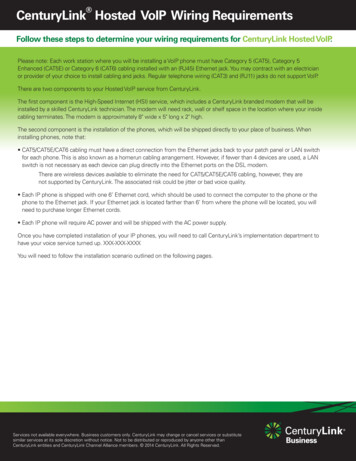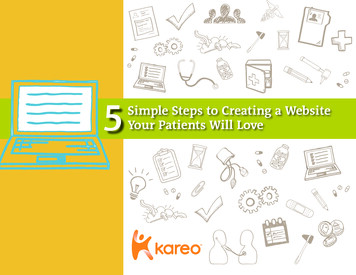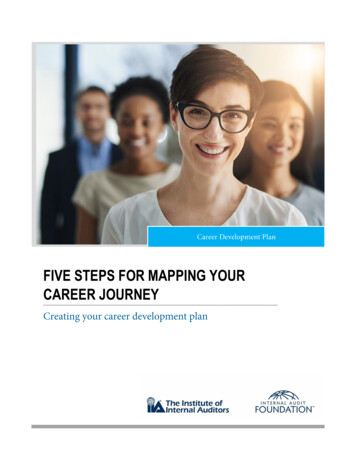
Transcription
FIVE STEPS FOR MAPPING YOURCAREER JOURNEY
Table of ContentsBeginning your Journey . 2Step 1: Establish your starting point — know where you are. . 2Step 2: Set your direction — identify where you want to go. . 2Mapping your Plan . 4Step 3: Plan your journey — explore how you will get there. . 4Step 4: Map your route —actions, measures, and timelines. . 4Staying on Track . 5Step 5: Monitor your progress and course-correct. . 5Career Development Plan Template . 61
BEGINNING YOUR JOURNEYCreating an Individual Development Plan (IDP) or a Career Development Plan (CDP) will help you establishboth short- and long-term career development goals; identify strategies for enhancing the competenciesnecessary to achieve those goals; and explore ways to leverage your strengths and talents within your currentposition to advance your career. Leveraging five simple steps, we will walk you through a process that willhelp you efficiently and effectively map your career journey.Step 1: Establish your starting point — know where you are.The first step in formulating your individual or career development plan is to understand where you are now— not only exploring your current role, but your talents, strengths, weaknesses, and competency level. Ask yourself the following questions:oHow satisfied am I with my role?oIf I were to make a change, what would it be?oHow do others currently view me? How do I want to be viewed by others?oWhat are my inherent strengths and talents?Assess your current competency with The IIA's Internal Audit Competency Framework :oDetermine your competency level within the 22 knowledge areas among four disciplines:Professionalism, Performance, Environment, and Leadership and Communications.The IIA's Internal Audit Competency FrameworkThe IIA's Internal Audit Competency Framework provides a clear andconcise professional development framework for internal auditors at everylevel of their career. The framework defines four knowledge areas focusedon various Standards, situationally specific functions, and key proficiencies,with three distinct competency levels that progress from general awarenessto applied knowledge, and finally, expert practitioner.The comprehensive and concurrent strategy defines and delivers the knowledge and skillsnecessary to navigate a successful career in internal auditing focused on best practices andpractical applications.2
Step 2: Set your direction — identify where you want to go.Once you have a firm understanding of your starting point, identify where you want to go next. You can pinpointboth interim stops and the ultimate destination for your career over the next five years. Discuss career opportunities with supervisors, colleagues, and mentors:oGain insight on the various paths they have taken on their career journeys.oShare interests and seek insights on their perceptions of you, your performance, and yourpotential.Reflect on your current organizational environment:oHow is your organization evolving to meet customer, client, and stakeholder needs?oWhat are the current and future demands on your position and department? How can youcontribute to success?Ask yourself the following questions:oIs my immediate focus on developing new skills to enrich my current job performance? oWhat specific skills do you need to develop?Is my next career step lateral, up, or over in another organization? On what specific role do you have your sights set?oWhat skills do you need to develop to qualify for that role?oWhat do I want to achieve in the next one, three, and five years?3
MAPPING YOUR PLANStep 3: Plan your journey — explore how you will get there.No two career journeys are the same. While individuals may move through the same sequence ofroles, each person has unique strengths to leverage and opportunities for development. To mapyour unique path, explore the requirements and competencies for the positions you aspire to overthe next five years. Your career plan should focus on capitalizing on your strengths and addressingopportunities to get you where you want to be. Review job descriptions for the positions that interest you most:oWhat knowledge, skills, abilities, and other characteristics (KSAOCs) do you need?oAssess the requirements against The IIA's Internal Audit Competency Framework .oIdentify the specific skills, experiences, and knowledge you need to acquire for your yearone, year three, and year five stops on your career journey.Step 4: Map your route — document actions, measures, and timelines.There are numerous ways to leverage your strengths and acquire the KSAOCs necessary toreach each stop on your career journey. Documenting the specific actions you will take, timelinesfor completion, and how each activity supports the achievement of your objectives helps establish acommitment toward achieving your career goals.Explore which activities will help you most on your career journey: Pursue an advanced degree, certificate, or professional certification.Engage in mentoring as a mentor or mentee.Lead projects or meetings.Develop and deliver presentations and reports.Assume additional tasks or take on challenging responsibilities withinyour current role.Participate in webinars, training, conferences, or chapter networkingevents.Lead or serve on cross-functional collaborative projects.Stay up to date on standards and trends in the profession — read thelatest guidance, articles, books, research, and more.Connect with your peers through association membership, professionalsocial media, and organizational team building.Volunteer with The IIA, your local chapter, or other community groups.4Mentoring can bea powerful tool forprofessionaldevelopment. Theright mentor canincrease apractitioner'svisibility withinthe company orindustry, helpvisualize a longterm career path,and providetactical supportalong the way.Source: Kick StartYour Audit Career,Ia Magazine
STAYING ON TRACKStep 5: Monitor your progress and coursecorrect.After you map your journey with the accompanyingdevelopment plan template, please share it with yoursupervisor or mentor and discuss your progress quarterlyto stay on track with your career journey.You may encounter detours, roadblocks, or take sideroads, so establishing regular check-ins with those youadmire and respect can help you course-correct or adjustyour plan to accommodate new destinations.Remember, this is your plan. You are the only oneaccountable for success. It is the actions you take andchoices you make that will move you forward through yourjourney.5Suggested Reading Wayfinding: Stories ofInternal Audit LeadersNavigating to Success The Speed of Risk: LessonsLearned on the Audit Trail,2ND EDITION Trusted Advisors: KeyAttributes of OutstandingInternal Auditors Collaborative Auditing
Career Development PlanName:Date:PROFESSIONAL GROWTH AND CAREER ASPIRATIONS GOAL STATEMENTSTATE WHAT YOU ULTIMATELY WANT TO ACHIEVE DURING YOUR CAREER. YOU CAN LIST A LONG-TERM AND A SHORT-TERM GOAL.STATE WHAT YOU ULTIMATELY WANT TO ACHIEVE DURING YOUR CAREER. YOU CAN LIST A LONG-TERM AND ASHORT-TERM GOAL.Talents/StrengthsDevelopment OpportunitiesIdentify three to five talents and strengths you can leverage in your careerplan.Identify KSAOCs needed to reach the destinations on your career journey.Objective #1State what you want to achieve within the next 12 months.Strategies/ActionsTarget CompletionSuccess MeasuresIdentify what specific strategies and supporting actions you will take tomeet this objective.Set a goal date for completion.Identify the indicator of success.QuarterlyCheck-ins6
Career Development PlanPage 2Objective #2State what you want to achieve within the next three years.Strategies/ActionsTarget CompletionSuccess MeasuresIdentify what specific strategies and supporting actions you will take to meet thisobjective.Set a goal date forcompletion.Identify the indicator of success.Strategies/ActionsTarget CompletionSuccess MeasuresIdentify what specific strategies and supporting actions you will take to meet thisobjective.Set a goal date forcompletion.Identify the indicator of success.QuarterlyCheck-insObjective #3State what you want to achieve within the next five years.QuarterlyCheck-ins7
ABOUT THE INTERNAL AUDIT FOUNDATIONThe Internal Audit Foundation strives to be an essential global resource for advancing the internal audit profession. The Foundation's research andeducational products provide insight on emerging topics to internal audit practitioners and their stakeholders and promote and advance the internalaudit profession's value globally. Through the Academic Fund, the Foundation supports the profession's future by providing grants to students andeducators who participate in The IIA's Internal Auditing Education Partnership Program. For more information, visit www.theiia.org/Foundation.ABOUT THE IIAThe Institute of Internal Auditors (IIA) is the internal audit profession's most widely recognized advocate, educator, and provider of standards, guidance,and certifications. Established in 1941, The IIA today serves more than 200,000 members from more than 170 countries and territories. Theassociation's global headquarters is in Lake Mary, FL. For more information, visit www.theiia.org.DISCLAIMERThe Internal Audit Foundation and The Institute of Internal Auditors publish this document for informational and educational purposes. This material isnot intended to provide definitive answers to specific individual circumstances and, as such, is only intended to be used as a guide. The Foundationand The IIA recommend seeking independent expert advice relating directly to any specific situation. The Foundation and The IIA accept noresponsibility for anyone placing sole reliance on this material.This content is for general information purposes only and should not be used as a substitute for consultation with professional advisors.COPYRIGHTCopyright 2020 by the Internal Audit Foundation, formerly The Institute of Internal Auditors Research Foundation (IIARF). All rights reserved.
Career Development Plan Template. 6 . 2 BEGINNING YOUR JOURNEY Creating an Individual Development Plan (IDP) or a Career Development Plan (CDP) will help you establish both short- and long-term career development goals; identify strategies for enhancing the competencies necessary to achieve those goals; and explore ways to leverage your strengths and talents within your current
